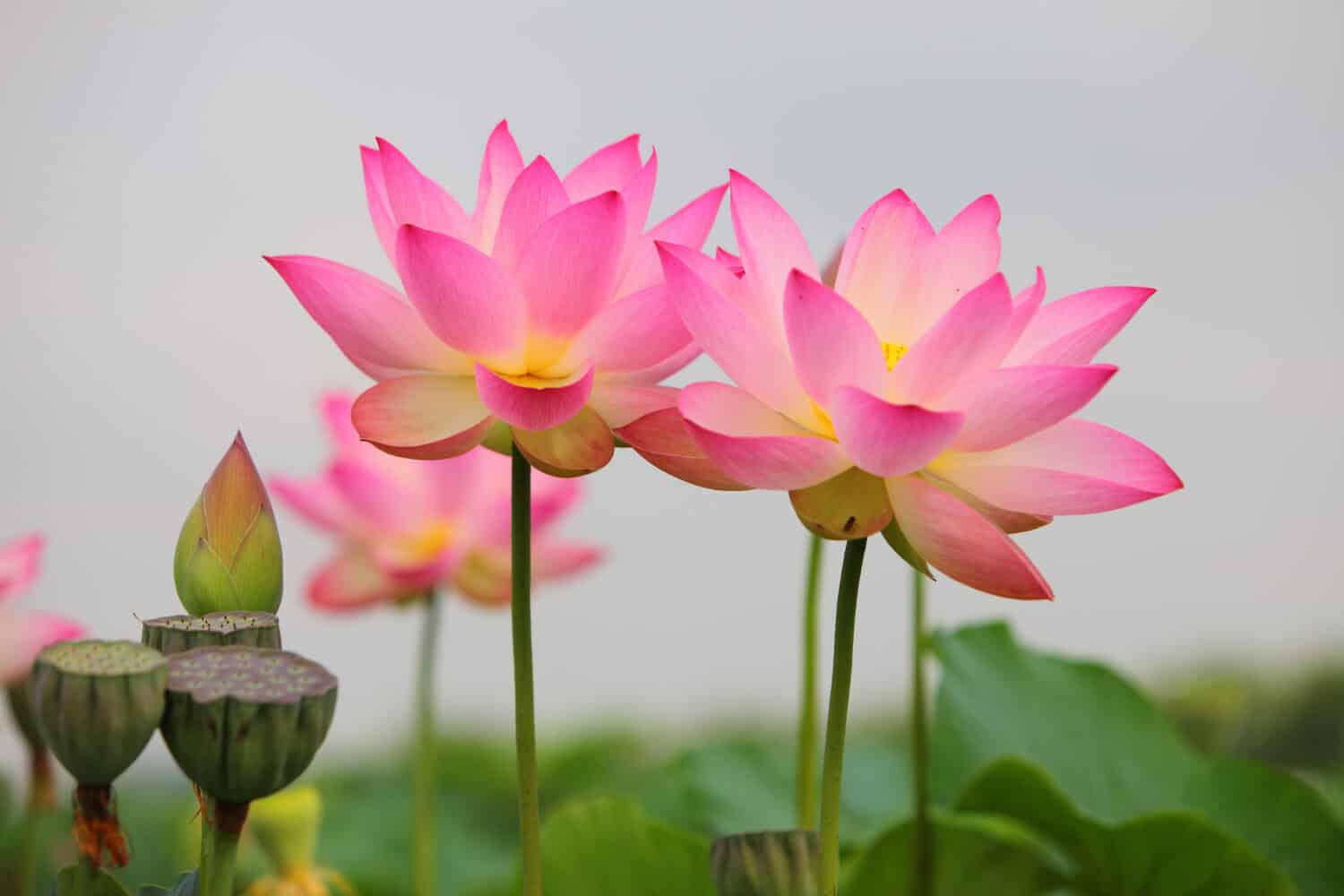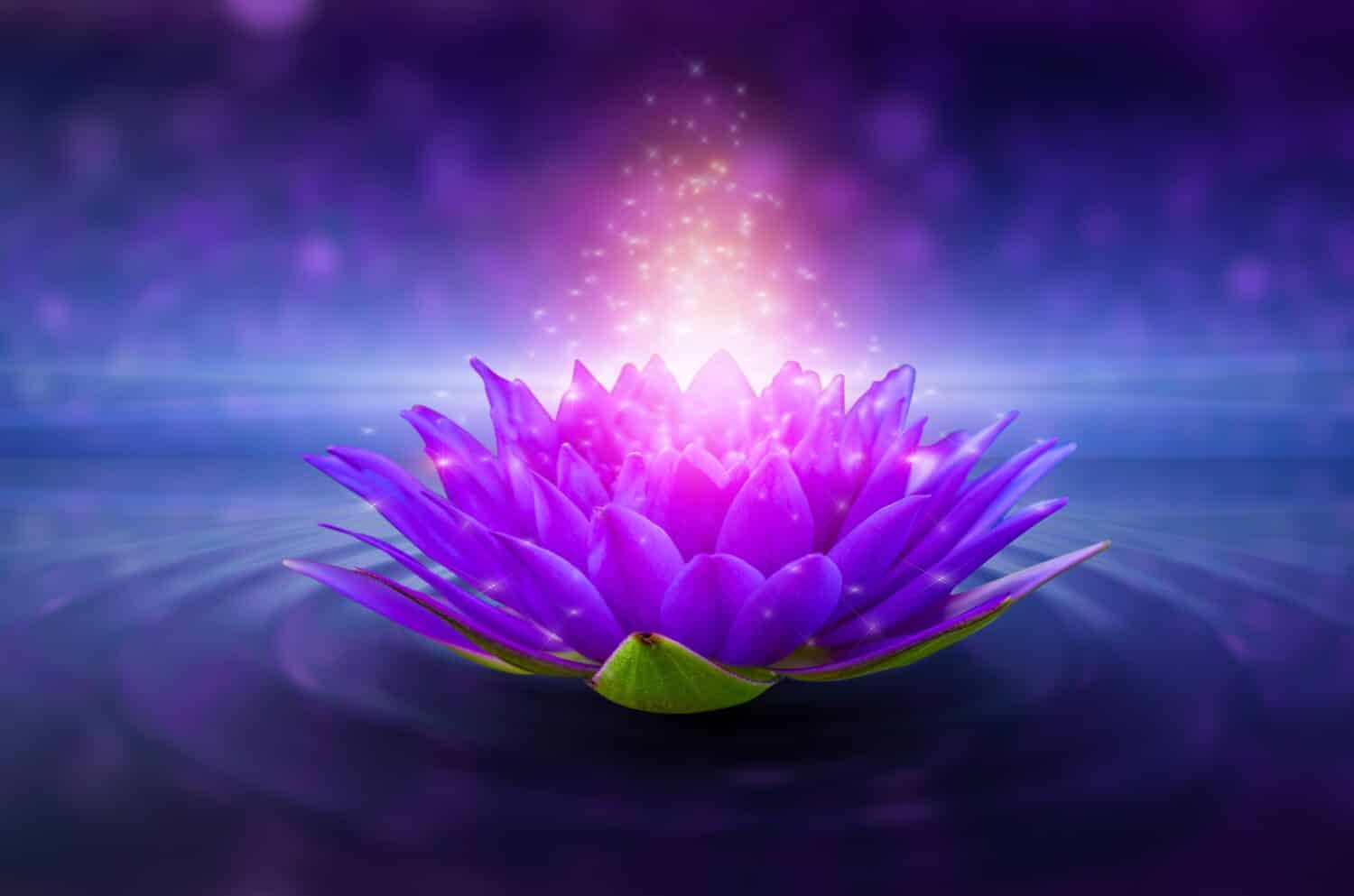Delicate and ethereal, the lotus flower emerges from tranquil waters like a botanical masterpiece, unfolding its perfect petals into a radiant and fragrant crown. This stunning flower has long been revered across various traditions and cultures. But what is it about this mysterious blossom that seems to so artfully soothe the mind and awaken the spirit? Let’s take a closer look at the deep meaning and symbolism of the lotus flower and what makes it so special!
What Is a Lotus Flower?
The lotus flower is a stunning aquatic plant with many incredible features. Producing elegant and stunning flowers, lotuses grow in water with long, crawling roots, and have been cultivated for at least 3,000 years in water gardens. There are two main species of lotus, the American lotus (Nelumbo lutea) and the sacred lotus or Indian lotus (Nelumbo nucifera). Although some people refer to water lilies as lotuses, they are actually from a different family. Only true lotuses belong to the Nelumbonaceae family, whereas water lilies belong to the Nymphaeaceae family.
Every year, these beautiful water-loving plants produce enormous amounts of seeds. These seeds drop down to the bottom of the ponds where the flowers live. Animals will eat most of them, but a few will sprout and grow into new lotus flowers. In addition, there are a handful that sometimes sink and stay dormant until the pond dries up. Later, if water once against floods the pond, these forgotten seeds will crack open and begin to grow.
Lotus seeds are incredibly resilient, and in the right conditions, they can stay alive for many, many years. In fact, some of these enduring lotus seeds can stay alive and even sprout hundreds of years later. Some of the oldest lotus seeds sprouted after a mind-blowing 1,300 years!

The leaves and blossoms of lotus flowers often grow above the water’s surface rather than resting on it.
©iStock.com/Lquang2410
Appearance
Lotus flowers live in tranquil ponds and rivers, firmly rooting themselves in the soil at the bottom. They have unique leaf stocks called petrioles, which can stretch up to an impressive length of over 6 feet tall! This remarkable feature allows the lotus plant to thrive even in deep water. At the top of the leaf stocks, the lotus’ large, water-repellent leaves delicately float along the surface of the water or gracefully rise above it.
Lotus flowers are large and round, each perched above their leaves like delicate porcelain figurines. With their striking colors and intricate smooth pedals, these flowers can grow as large as 12 inches in diameter! Lotus blossoms typically have around 20 petals. However, some varieties, like the Chinese qian ban lian or “thousand petal lotus”, have over a thousand petals growing from a single blossom!
Another extraordinary feature of lotus flowers is that they can also thermoregulate. Much like how humans and other warm-blooded animals try to maintain a comfortable body temperature, lotus flowers also strive to keep their blossoms within a narrow range of warmth. Scientists believe this helps them to create a welcoming environment that attracts cold-blooded insect pollinators.

The American water lotus is endangered in many U.S. states.
©Hernando Sorzano/Shutterstock.com
Native Habitat
There are two living species of lotus flowers. The first is the sacred lotus or Indian lotus (Nelumbo nucifera), which is native to Asia and Australia. Growing two heights of 3 to 6 feet, these magnificent plants thrive in shallow water. They spread their roots through thickened rhizomes rooted in the muddy bottoms of slow-moving water bodies, like ponds, flood plains, and deltas. Their fragrant blossoms come in beautiful hues of pink or white with golden yellow centers and open up in the morning and close back up again at night. The lotus plant’s rhizomes, leaves, and seeds are edible and are often used in Asian cooking.
The American lotus (Nelumbo lutea), on the other hand, is native to North America and the Caribbean where it grows in flooded areas, swamps, and lakes. American lotus flowers also anchor their roots in the mud, while their leaves and flowers reach above the water’s surface. Their delicate blossoms are pale yellow, cream, or white, with a golden yellow center. Native Americans used American lotus plants as a food source and spread them throughout the northern United States.

Lotus blossoms can grow to 12 inches wide!
©iStock.com/Maria Marganingsih
Growing Tips
Lotus flowers thrive in watery environments that are at least 12 inches deep but can thrive in water as deep as 8 feet. They are well-adapted to aquatic environments, but they are not naturally cold-hardy. However, lotus flowers are remarkably adaptable, adjusting and thriving in many different conditions as long as they have the right environment.
In colder climates, where temperatures drop significantly, having deeper water levels is actually quite beneficial for lotus flowers. The deep water acts as a protective shield or cozy blanket that keeps the plants’ tubers safe. This allows them to withstand the harsh and bitter cold and ensures better growth and flowering when spring arrives.
Lotus flowers require nutrient-rich and loamy soil with a loose and crumbly texture full of essential nutrients. This provides the perfect foundation for the flowers to anchor their roots and absorb the nourishment they need to grow. They also need plenty of sun, so you should plant them in areas with at least six hours of direct full sun every day.
Lotus flowers are herbaceous perennials and bloom from June to July. When fall approaches, it’s vital to make the necessary preparations for your lotus flowers to survive the winter. If you have containers with lotus plants submerged in shallow water, you’ll need to move them into deeper water or bring them indoors to a frost-free area where they can overwinter until spring.

The leaves of lotus flowers have tiny bumps and waxy tubes that repel water.
©komkrit Preechachanwate/Shutterstock.com
Lotus Flower Meaning and Symbolism
The lotus flower has been revered for hundreds and even thousands of years due to its historical, cultural, and spiritual meaning and symbolism. In fact, there are relief sculptures from the Achaemenid period (552 BCE) that feature sacred lotus flowers. In addition, many artworks of Hinduism and Buddhism feature lotus flowers as the seat or base of many important figures and deities. Lotus flowers are also used frequently as powerful visual elements in Jain artwork as well. Next, let’s take a look at the meanings and symbolism of the lotus flower.

Birth and Creation
In Hinduism, the sacred lotus, or Indian lotus, holds a particularly special place of reverence. Cherished as a sacred plant, the lotus flower is the very first creation and a symbol of new beginnings. The lotus flower serves as the mystical womb of the universe, symbolizing divine potential and bringing it into reality. It serves as a bridge between the spiritual and physical world, bringing forth life and embodying divine essence.
Rebirth, Renewal, and Resilience
The roots of the lotus flower anchor deep within muddy depths, while the plant’s pristine flowers rise far above the murky waters, leaving its soft petals untouched and untainted. Because of this, the lotus flower is a symbol of birth and rebirth. Each beautiful blossom signifies a profound journey from darkness to light.
In astrology, the lotus flower is a symbol of the rising sun. Just as the sun rises above the darkness of night and brings light to the world, the lotus flower rises above the mud and blooms brilliantly above the water. In addition, lotus flowers are extremely resilient. In fact, scientists germinated a lotus plant from ancient seeds found in a dry lakebed in northeastern China. They estimated that the seeds were 1,300 years old! This is another reason that the lotus represents rebirth and renewal, as well as longevity.
Beauty and Purity
The Hindu goddess Lakshmi is associated with the lotus in many ways, going back to the ancient Rig-Veda. Representing fertility, abundance, richness, and royalty, Lakshmi is deeply connected to the lotus flower. The lotus symbolizes peace, purity, prosperity, and beauty, just like the qualities embodied by Lakshmi herself.
Lotus flowers symbolize beauty, even amidst challenges and difficult circumstances. They grow in murky and muddy water, and yet they still produce beautiful, pristine blossoms. Following the Christian Council of Ephesus in 431 A.D., many sacred spaces were decorated with beautiful lotus flowers to symbolize and honor the beauty and purity of Mary, the mother of Jesus.

Lakshmi has a deep connection with the lotus flower and is often called the “Lotus Goddess”.
©Cavan-Images/Shutterstock.com
Enlightenment and Spiritual Awakening
Many religions, including Hinduism and Buddhism, revere the lotus flower as a sacred representation of the path to enlightenment and spiritual awakening. In the Bhagavad-gita, the great deity Brahma sits on a majestic lotus throne. The lotus is also connected to the Eightfold Path. Each petal represents a crucial element of the path, serving as metaphorical stepping stones along the journey to self-realization and enlightenment. Buddha himself is often portrayed seated upon a lotus blossom as well.
The artworks of Hinduism commonly include lotus flowers. Associated with the gods and goddesses, lotus flowers act as a bridge between the divine and earthly realms. When water droplets fall onto a lotus blossom, they gracefully glide off, leaving the flower’s petals untouched. This also serves as a metaphor for someone who is spiritually minded and willing to let go of their attachments to the material world.
Meaning and Symbolism of Lotus Flower Colors
White Lotus Flower
One of the things that really sets a white lotus apart is its remarkable contrast against the murky waters where it thrives. This beautiful lotus flower defies expectations, flourishing in what would appear to be an inhospitable environment. However, rather than blooming in spite of this, the environment is precisely what the flower needs in order to thrive and produce its pristine white blossoms. The white lotus serves as a reminder that even in the most unfavorable circumstances, we have the capacity to transcend our surroundings and manifest our inherent goodness and light.
Sarasvati, the Hindu goddess of knowledge in the arts, is commonly featured with a beautiful white lotus. Dressed in a white saree and accompanied by white swans, she represents the intrinsic power and sanctity of knowledge, capable of Illuminating even the darkest corners of ignorance and strife. The color white in this way symbolizes an embodiment of the divine, unveiling the mysteries of the mind and granting mortals the ability to create, innovate, and express their hearts and souls.

Many artists depict Sarasvati standing gracefully atop a large lotus flower.
©Ibenk_88/Shutterstock.com
Yellow Lotus Flower
The soft petals of a yellow lotus flower radiate joy, curiosity, and confidence. Like many religious beings infused with divine energy, these stunning blossoms embody the essence of openness, hospitality, and warmth, inviting us to bask in their luminous aura. In Buddhism, the Golden Lotus flower symbolizes Buddha and the succession of Buddhas, reflecting wisdom, enlightenment, and compassion.

The American lotus has beautiful pale yellow petals.
©Aria_RJWarren/Shutterstock.com
Pink Lotus Flower
The pink-colored Indian lotus (Nelumbo nucifera) is the national flower of both India and Vietnam. Few symbols hold as much profound significance as the lotus flower, which is deeply entwined with the countries’ ancient traditions, religions, and mythology. Many of the divine figures of Hindu art are accompanied by pink or pink-tipped lotus flowers.
A pink lotus plant, with its bud tightly closed, serves as a powerful metaphor for the beginning stages of one’s spiritual path. Each petal unfurls gracefully, like a soul reaching out towards the heavens, as the purest essence of wisdom and understanding takes root within the individual. A fully bloomed pink lotus flower symbolizes the culmination of years of dedication, devotion, and contemplation, as the seeker of truth emerges from the depths of ignorance to embrace the infinite possibilities of enlightenment.

The buds and blossoms of pink lotus flowers symbolize various stages on the path to enlightenment.
©Binspapa/Shutterstock.com
Blue Lotus
There are no natural blue lotus flowers in nature. However, in Buddhist iconography, the blue lotus serves as an important symbol. Blue lotus flowers symbolize wisdom and knowledge. They also symbolize intelligence, logic, and mastery of the spirit over our material senses. Mañjuśrī, a revered Buddhist bodhisattva associated with wisdom, is often depicted with a blue lotus. In addition, within some schools of Buddhism, the blue lotus never fully opens, so you cannot ever truly see its center. The blue lotus reminds us that there is always more to learn and discover.

The Vishuddha chakra mandala in ancient meditation practices features a blue lotus flower.
©shooarts/Shutterstock.com
Red Lotus
Although red lotus flowers do not exist in nature, in eastern art they often symbolize our original nature. Red lotuses are associated with the purity of the heart, symbolizing compassion, love, and passion. In Tibetan Buddhism, the red lotus is the flower of the bodhisattva of compassion, Avalokiteshvara. Referred to as the paramahrdaya or the “innermost heart” of Avalokiteshvara, the Sanskrit mantra Oṃ maṇi padme hūṃ means “praise to the jewel of the lotus” or “Om, the jewel (of creation) is the lotus”. Another Bodhisattva associated with compassion, Guanyin, is often depicted sitting upon a red lotus or surrounded by showers of red lotus flowers.

Divine beings like gods and goddesses often sit upon lotus thrones.
©Alex. Shevchenko/Shutterstock.com
Purple Lotus
The purple lotus is rare, which makes it quite captivating in the symbolism of esoteric Buddhism. The deep, rich hues of purple lotus flowers exude an aura of otherworldliness and enticement, with a seemingly infinite number of secrets held within their clustered petals. The number of purple lotus flowers gathered together can unveil a multitude of meanings. For example, a single purple lotus flower may symbolize purity and spiritual enlightenment. On the other hand, a group of three purple lotus flowers might represent the union of mind, body, and spirit. As the number increases, so does the complexity of the message conveyed.

The purple lotus flower serves as a reminder of the infinite possibilities of a spiritual journey.
©sarayut_sy/Shutterstock.com
Proper Occasions for Lotus Flowers
Birthdays and Anniversaries
With their enchanting beauty and rich symbolism, lotus blossoms are perfect gifts for celebrating new beginnings and important milestones, such as new births, birthdays, or anniversaries. Emerging from their muddy waters, lotus flowers represent growth and transformation. They also bloom amidst challenging conditions and serve as a reminder of resilience and strength, which makes them excellent gifts to mark significant moments in life. In addition, as the lotus flower is a symbol of spiritual awakening and rebirth, it is also an excellent present for those embarking on a new chapter.
Weddings
The lotus flower is a beautiful choice for weddings, serving as a symbol of the couple’s journey of love and unity. With their large blossoms, lotus flowers reflect the blooming love between two souls and the essence of their bond and commitment. Like a lotus flower, the new couple will need to remember to rise above challenges, emerging stronger and more resilient together. In addition, lotus flowers are exquisite and elegant, and make excellent additions to floral arrangements and centerpieces.

Lotus flowers are beautiful symbols for floral arrangements and other elegant wedding decorations.
©CH.SUNSHY/Shutterstock.com
Graduations and Achievements
Delicate yet resilient, lotus flowers stand as a symbol of a pure mind, wisdom, and enlightenment. This makes them great for celebrating graduations and other important achievements. In addition, with their roots anchored deep in murky waters, lotus flowers rise above challenges and bloom triumphantly, just as new graduates emerge from the painstaking journey of their educational pursuits. The gift of a lotus flower is not only a beautiful token, but also a powerful reminder of their educational journey and its transformative power.
Cooking
Not only are lotus flowers exceptionally beautiful, but many cultures use various parts of these incredible plants in their culinary practices. For example, lotus flowers and leaves are popular in herbal teas. In many Asian countries, the rhizomes of lotus plants are often eaten as a vegetable, either fried or cooked. Some Vietnamese and Thai dishes include young lotus stems and stalks of the flower in various salads, soups, and curries.
Yoga and Meditation
The ethereal beauty of an elegant lotus flower serves as a poignant reminder of our own inner beauty and resilience. This makes lotus flowers not only beautiful decorations but also powerful symbols during moments of meditation or while engaging in yoga.
In fact, in yoga, there’s a posture called the Lotus Pose or “padmasana”. This pose is a deep stretch for the hips, as you sit cross-legged with both feet delicately placed upon each opposite thigh. Emulating the beauty and tranquility of a blooming lotus, the Lotus Pose facilitates harmonization of the root chakra and grounds the base of the spine firmly into the earth.

Lotus pose has many benefits, but you should be careful as it can also cause injury if done incorrectly.
©A.Azarnikova/Shutterstock.com
Thank you for reading! Have some feedback for us? Contact the AZ Animals editorial team.







